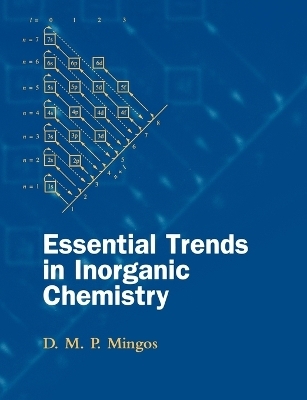
Essential Trends in Inorganic Chemistry
Seiten
1998
Oxford University Press (Verlag)
978-0-19-850108-4 (ISBN)
Oxford University Press (Verlag)
978-0-19-850108-4 (ISBN)
The book's central feature is a detailed discussion of the important horizontal, vertical, and diagonal trends in the properties of the atoms of the elements and their compounds. By the end of the book the student will have learned the basic methodology and will be able to apply these principles to other problems and to more detailed acocunts of modern inorganic chemistry.
The growth of inorganic chemistry during the last fifty years has made it almost impossible for the student to assimilate all the factual information available. This book is designed to help the student begin to tackle this task by showing exactly how a chemist uses the Periodic Table to organize and process this mass of information. After opening with a clear description of the quantum mechanical basis of the Periodic Table, the author goes on to illustrate how a modern inorganic chemist uses the basic structure of the Periodic Table to interpret a wide range of chemical phenomena. Rather than giving the descriptive chemistries of the groups of elements, the author takes specific atomic, physical, and chemical properties and illustrates how the variations are interpreted. Thus he describes vertical trends, horizontal and diagonal trends, and then isoelectronic relationships. The latter provides a basis for developing bonding models which account for the structures and reactivities of molecules. Finally he describes the horizontal and vertical relationships associated with the transition metals, the lanthanides, and the actinides. The basic methodology developed in Essential trends in inorganic chemistry will enable the student to apply these basic principles to other problems and to assimilate more detailed accounts of modern inorganic chemistry in a structured way. D. M. P. Mingos is Sir Edward Frankland BP Professor of Inorganic Chemistry at Imperial College of Science, Technology and Medicine, London, and Dean of the Royal College of Science. He is the author of Essentials of inorganic chemistry (1995) also published by Oxford University Press and Introduction to Cluster Chemistry (with D. J. Wales).
The growth of inorganic chemistry during the last fifty years has made it almost impossible for the student to assimilate all the factual information available. This book is designed to help the student begin to tackle this task by showing exactly how a chemist uses the Periodic Table to organize and process this mass of information. After opening with a clear description of the quantum mechanical basis of the Periodic Table, the author goes on to illustrate how a modern inorganic chemist uses the basic structure of the Periodic Table to interpret a wide range of chemical phenomena. Rather than giving the descriptive chemistries of the groups of elements, the author takes specific atomic, physical, and chemical properties and illustrates how the variations are interpreted. Thus he describes vertical trends, horizontal and diagonal trends, and then isoelectronic relationships. The latter provides a basis for developing bonding models which account for the structures and reactivities of molecules. Finally he describes the horizontal and vertical relationships associated with the transition metals, the lanthanides, and the actinides. The basic methodology developed in Essential trends in inorganic chemistry will enable the student to apply these basic principles to other problems and to assimilate more detailed accounts of modern inorganic chemistry in a structured way. D. M. P. Mingos is Sir Edward Frankland BP Professor of Inorganic Chemistry at Imperial College of Science, Technology and Medicine, London, and Dean of the Royal College of Science. He is the author of Essentials of inorganic chemistry (1995) also published by Oxford University Press and Introduction to Cluster Chemistry (with D. J. Wales).
Chapter 1 The quantum mechanical basis of the periodic table ; Chapter 2 Vertical trends ; Chapter 3 Horizontal and diagonal trends ; Chapter 4 Isoelectronic and iso-stoichiometric relationships ; Chapter 5 Transition metals (d-block elements), lanthanides and actinides (f-block elements)
| Erscheint lt. Verlag | 29.1.1998 |
|---|---|
| Zusatzinfo | numerous line figures, tables |
| Verlagsort | Oxford |
| Sprache | englisch |
| Maße | 190 x 246 mm |
| Gewicht | 880 g |
| Themenwelt | Naturwissenschaften ► Chemie ► Anorganische Chemie |
| ISBN-10 | 0-19-850108-0 / 0198501080 |
| ISBN-13 | 978-0-19-850108-4 / 9780198501084 |
| Zustand | Neuware |
| Informationen gemäß Produktsicherheitsverordnung (GPSR) | |
| Haben Sie eine Frage zum Produkt? |
Mehr entdecken
aus dem Bereich
aus dem Bereich
Schulbuch Klassen 7/8 (G9)
Buch | Hardcover (2015)
Klett (Verlag)
31,50 €
Buch | Softcover (2004)
Cornelsen Verlag
25,99 €



